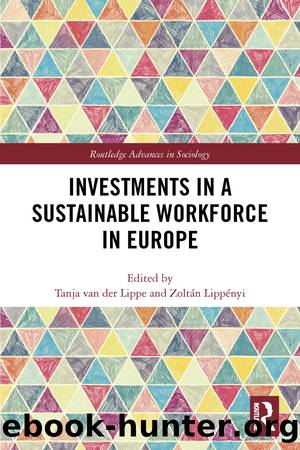Investments in a Sustainable Workforce in Europe by Tanja van der Lippe Zoltán Lippényi

Author:Tanja van der Lippe, Zoltán Lippényi [Tanja van der Lippe, Zoltán Lippényi]
Language: eng
Format: epub
Tags: Business & Economics, Labor, General, Organizational Behavior, Social Science, Sociology
ISBN: 9781351105323
Google: eSI0zgEACAAJ
Publisher: Taylor & Francis Group
Published: 2019-01-15T03:47:46+00:00
HR investments in employability
Employability can be defined as the extent to which workers are able and willing to work productively. The term âproductive workâ refers to adequately performing oneâs current job or, in the event of change, other tasks or jobs (Van Harten, Knies, & Leisink, 2015). Careers are extended because of an aging population and, in combination with other developments such as ongoing technological innovation, it is of vital importance that employees do not only have the ability to perform their current job, but are motivated to continue working in constantly changing work environments as well (Van den Broeck et al., 2014). This means that employability consists of up-to-date expertise or competences together with a willingness to continually develop and adapt to changes in the work environment. Such attributes help employees survive in contemporary turbulent labor markets (Thijssen, Van der Heijden, & Rocco, 2008).
It is argued that employability has benefits for both organizations and employees, and research shows the positive effects of employability on individualsâ job performance (Kinnunen, Mäkikangas, Mauno, Siponen, & Nätti, 2011), commitment (De Cuyper & De Witte, 2011) and health (Berntson & Marklund, 2007). Many organizations therefore develop and implement practices aimed at increasing their employeesâ employability (Fleischmann, Koster, & Schippers, 2015; Veld, Semeijn, & Vuuren, 2015). However, research examining the effectiveness of these practices is largely lacking (Van Harten et al., 2017).
In addition, employability studies tend to focus merely on HR practices aimed at training and development, as such practices can stimulate the growth and maintenance of employeesâ capabilities and motivations. Although development investments have been shown to contribute to employability, other sets of HR practices could be important as well (Van Harten et al., 2017). Development practices can be expected to primarily boost individualsâ capabilities and development motivations; however, as described above, employability consists of more than just these aspects. Offering flexible work arrangements could be another important way to boost employability as it enhances employee flexibility and adaptability by, among other things, providing employees with the opportunity to balance work and family demands (Stavrou, 2005).
In this study we aim to expand the focus on development HR in employability research and examine the performance and well-being effects of two different sets of HR practices that are likely to stimulate employability: (1) training and development opportunities; and (2) flexible work arrangements. The two sets are included in this chapter as they are directly linked to the two elements of our definition of employability. As illustrated above, both sets can be expected to relate to these two elements; essentially, training and development opportunities can be expected to primarily stimulate abilities and development motivations, while flexible work arrangements are likely to primarily stimulate flexibility/adaptability motivations.
Download
This site does not store any files on its server. We only index and link to content provided by other sites. Please contact the content providers to delete copyright contents if any and email us, we'll remove relevant links or contents immediately.
The Brazilian Economy since the Great Financial Crisis of 20072008 by Philip Arestis Carolina Troncoso Baltar & Daniela Magalhães Prates(105892)
International Integration of the Brazilian Economy by Elias C. Grivoyannis(75671)
The Art of Coaching by Elena Aguilar(52211)
Flexible Working by Dale Gemma;(23213)
How to Stop Living Paycheck to Paycheck by Avery Breyer(19570)
The Acquirer's Multiple: How the Billionaire Contrarians of Deep Value Beat the Market by Tobias Carlisle(12115)
Thinking, Fast and Slow by Kahneman Daniel(11806)
The Radium Girls by Kate Moore(11636)
The Art of Thinking Clearly by Rolf Dobelli(9930)
Hit Refresh by Satya Nadella(8869)
The Compound Effect by Darren Hardy(8524)
Atomic Habits: Tiny Changes, Remarkable Results by James Clear(8055)
Tools of Titans by Timothy Ferriss(7828)
Turbulence by E. J. Noyes(7717)
Change Your Questions, Change Your Life by Marilee Adams(7388)
A Court of Wings and Ruin by Sarah J. Maas(7284)
Nudge - Improving Decisions about Health, Wealth, and Happiness by Thaler Sunstein(7261)
How to Be a Bawse: A Guide to Conquering Life by Lilly Singh(7162)
Win Bigly by Scott Adams(6833)
